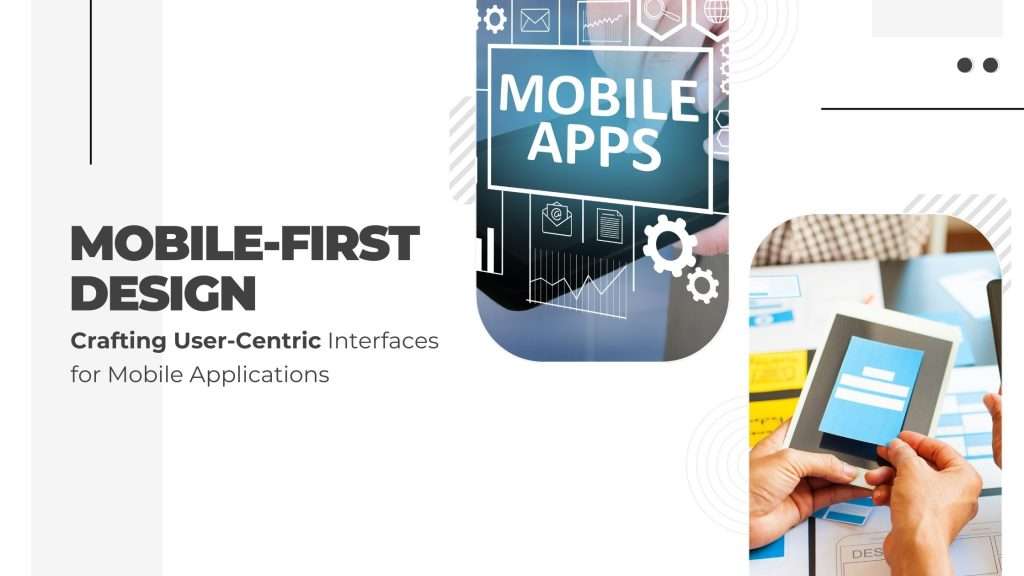Are you tired of websites and applications that don’t quite fit on your mobile screen? Don’t worry, you’re not alone. The world has gone mobile, and it’s high time for designers to catch up! Welcome to our blog post on ‘Mobile-First Design: Crafting User-Centric Interfaces for Mobile Applications.’
In this digital era where smartphones are king, we’ll explore the importance of putting mobile users first and how designing with their needs in mind can lead to engaging, intuitive interfaces that captivate audiences. Get ready to dive into a world where the small screen reigns supreme – let’s revolutionize mobile design together!
Introduction to Mobile-First Design
When it comes to mobile app design, the focus is no longer on solely creating a beautiful interface. Instead, designers are now being tasked with creating user-centric interfaces that prioritize function over form. In other words, mobile-first design is all about putting the user’s needs first and foremost.
The reason for this shift is obvious: we now live in a world where people are constantly on their phones. In fact, recent studies have shown that Americans now spend an average of 5 hours per day on their smartphones. And with more and more people using their phones as their primary internet device, it’s no surprise that companies are starting to take notice.
With mobile-first design, the goal is to simplify the user experience bystripping away superfluous features and functionality. The focus is on creating an interface that is easy to use and navigate, while still providing all of the necessary information and functionality. This can be a challenge, but when done right, mobile-first design can result in a much better overall experience for the user.
Benefits of a User-Centric Interface on Mobile Applications
There are many benefits to having a user-centric interface on mobile applications. The most important benefit is that it helps create a better user experience. When users have an easy time navigating your app and finding the information they need, they are more likely to use it and recommend it to others.
In addition, a user-centric interface can help increase conversion rates and improve customer satisfaction. If customers can easily find what they are looking for on your app, they are more likely to make a purchase or take the desired action.
Having a user-centric interface can also help you save time and money. By making sure that your app is designed with the user in mind, you can avoid costly redesigns down the line.
Design Principles to Consider When Creating Interfaces
There are many design principles to consider when creating interfaces for mobile applications. Here are a few important ones:
- Keep it simple: Mobile users have limited attention spans and patience, so it’s important to keep your interface simple and easy to use. Stick to the essentials and don’t try to pack too much into one screen.
-
Make it intuitive: Users should be able to figure out how to use your interface without needing extensive instructions or tutorials. This means keeping things self-explanatory and using familiar icons and conventions where possible.
-
Consider the context: Mobile users often use their devices in different contexts than desktop users, so it’s important to take this into account when designing your interface. For example, people might use your app while walking or commuting, so you need to account for that in your design.
-
Optimize for touch: Since mobile users will be interacting with your interface through touch, it’s important to optimize for this input method. This means making sure buttons and controls are big enough to be tapped easily, and avoiding features that require precise finger movement (such as complex gestures).
-
Test on real devices: It’s crucial to test your interface on actual mobile devices before launch, not just in the simulator or emulator. This will help you catch any issues that only occur on real hardware, such as problems with touchscreen sensitivity or screen size differences between devices.
Tools and Platforms to Help Build Interfaces
When it comes to crafting user-centric interfaces for mobile applications, there are a number of tools and platforms that can be extremely helpful. In this section, we’ll take a closer look at some of the most popular options.
One of the best tools for mobile interface design is Adobe Photoshop. With Photoshop, you can easily create high-resolution interface designs that look great on any type of device. Photoshop also offers a wide range of features and plugins that can help you streamline your workflow.
Another popular tool for mobile interface design is Sketch. Unlike Photoshop, Sketch was specifically designed for interface design. As such, it offers a number of features and plugins that make it ideal for mobile interface designers.
In terms of platforms, one of the best options for mobile interface development is React Native. React Native is a cross-platform framework that allows you to develop native iOS and Android apps using JavaScript. Thanks to its powerful features and flexibility, React Native is becoming increasingly popular among mobile developers.
We should mention Flutter. Flutter is an open-source platform developed by Google that allows you to create cross-platform applications with ease. Thanks to its intuitive programming language and easy-to-use widgets, Flutter is perfect for those who want to create beautiful interfaces without having to deal with complex codebases.

Usability Testing for Your Mobile Application
User experience (UX) is critical for the success of any mobile application. To ensure your app is providing the best possible UX, it’s important to regularly conduct usability testing. Usability testing allows you to identify any areas of your app that may be confusing or difficult for users, and then make necessary adjustments to improve the overall user experience.
There are a few different ways to approach usability testing for your mobile application. One option is to use a service like UserTesting.com, which provides on-demand access to real human users who can test your app and provide feedback. Another option is to use a tool like Apptimize, which enables you to A/B test different versions of your app with live users in order to determine which design elements are most effective.
Whichever method you choose, regular usability testing should be a key part of your mobile app development process in order to ensure that your app provides the best possible user experience.
Best Practices for Crafting Interfaces
When it comes to crafting interfaces for mobile applications, there are a few best practices that you should keep in mind. First and foremost, always keep the user in mind. What do they need to accomplish with your app? How can you make their experience as smooth and easy as possible?
Another important best practice is to keep things simple. Mobile users are typically looking for quick, easy answers or solutions. They don’t want to have to wade through tons of text or navigate complex menus. Keep your interface clean and streamlined, with obvious buttons and icons.
Always test your interfaces on real devices before you launch. Make sure that everything looks and works the way it should on different screen sizes and operating systems. There’s nothing worse than launching an app only to find out that the interface doesn’t work properly!
– Common Pitfalls When Designing User Interfaces
When it comes to designing user interfaces for Mobile-First Design, there are a few common pitfalls that can trip up even the most experienced designers. Here are a few of the most common pitfalls to watch out for when crafting user-centric interfaces for mobile applications:
- Not taking advantage of the unique capabilities of mobile devices. Mobile devices offer a variety of unique capabilities that can be leveraged to create more effective and efficient user interfaces. For example, the use of touch screen input can greatly simplify navigation and provide a more immersive experience for users.
2. Overlooking the importance of context. The context in which users will be using your app is critical in determining what sort of interface will be most effective. Will users be primarily using your app while on the go? In that case, an interface that is optimized for quick and easy access to key features may be best. Or will users be using your app in more sedentary situations? In that case, a richer and more robust interface may be appropriate.
- Failing to account for different screen sizes and aspect ratios. With the vast array of different mobile devices on the market today, it’s important to design your user interface in a way that is responsive and adaptable to different screen sizes and aspect ratios.
4. Neglecting accessibility considerations. It’s important to keep in mind that not all users will have the same level of ability when it comes to using your app. By taking into account accessibility considerations from the start, you can
– Conclusion
Mobile devices are becoming increasingly ubiquitous, which has led to a shift in how users access information and interact with businesses. As a result, businesses must adapt their strategies to account for the mobile-first mentality of their customers.
One way to do this is by crafting user-centric interfaces for mobile applications. This means creating an interface that is optimized for the smaller screen size and touch input of mobile devices. Additionally, it is important to consider the different contexts in which users will be accessing your app, as this will impact how they use it.
By keeping these things in mind, you can create a mobile application that provides a great user experience and meets the needs of your customers.

